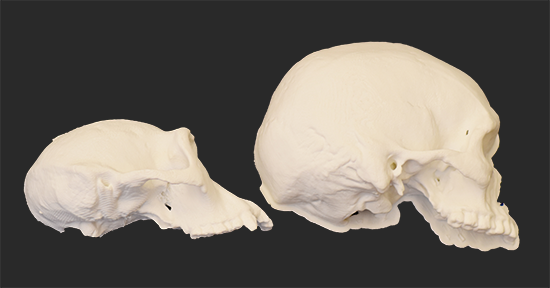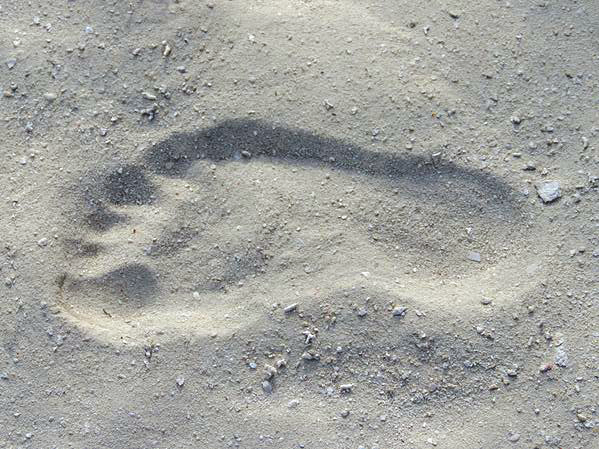
Head to Head
Before you begin
The modern human brain is the largest and most complex of any living primate. As you discovered in this activity, it is also larger than the brains of our ancient human ancestors. Our ancestors had brains closer in size to a chimpanzee than to a modern human. What made these ancestors special?
This activity will demonstrate the difference in brain size between humans, chimpanzees (our closest living relatives), and early human ancestors, called hominins.
What does brain size have to do with our biology? Before you begin, examine the skulls in front of you and see if you notice anything different about the three individual’s brain cases (the hollow portion where the brain fits).

What you will need
- Replica human skull half
- Replica chimp skull half
- Replica hominin skull half (we used an Australopithecus africanus skull, specimen: STS 71)
- Pitcher of water (will need to refilled periodically)
- 2 Graduated cylinders or beakers, 500 mL capacity
- Modeling clay (optional, see “For instructors” section)
- Tray to help contain spills
- Towels to mop up spills
- Experiment procedures [PDF]
Procedure
Animals with bigger brains have bigger skulls. We can compare the size of these skulls by seeing how much water they hold. Which brain do you think is biggest?
1. Start with the chimp skull. Turn it upside down. Use the pitcher to fill it with water.

2. Now, carefully pour the water from the skull into the beaker.

3. Look at the lines on the side of the beaker to see how many milliliters (ml) of water were in the skull. Fill that information in on a data sheet.

4. Try the same thing with the other skulls. Which one holds the most water? Do your results surprise you?
Learn more
Like all living things, early humans evolved in response to their environment. As they faced new environmental challenges, hominin bodies grew bigger and their brains became more complex. In fact, human brain size has tripled over the course of human evolution!
It’s not just the size of our brains that counts—it’s also the complexity. After all, elephants, whales, and dolphins have larger brains than we do. Humans are so intelligent because some areas of our brain are especially well developed compared to other animals. We have a very large neocortex, which is the exterior layer of our brains. This area controls language, thinking, and fine motor skills—allowing us to communicate, make and use tools, and many other things.
Within the human species, relative brain size doesn’t determine intelligence. Some people do have bigger heads (and brains), but they aren’t necessarily smarter. We all have the same type of brain that works the same way.
Our large brains do come at a cost. Human brains use up about 20% of our daily energy for our entire bodies, even though the brain only accounts for 2% of our body mass. We have use our intelligence to get food to feed our brains!
Bibliographic Details
- Article: Head to Head
- Author(s): Amy Peterson
- Publisher: Arizona State University Institute of Human Origins Ask An Anthropologist
- Site name: ASU - Ask An Anthropologist
- Date published:
- Date modified:
- Date accessed: January 16, 2026
- Link: https://askananthropologist.asu.edu/experiments/head-to-head
APA Style
Amy Peterson. (). Head to Head. Retrieved 2026, Jan 16, from {{ view_node }}
American Psychological Association, 6th ed., 2nd printing, 2009.
For more info, see the
APA citation guide.
Chicago Manual of Style
Amy Peterson. "Head to Head." ASU - Ask An Anthropologist. Published . Last modified . https://askananthropologist.asu.edu/experiments/head-to-head.
Chicago Manual of Style, 17th ed., 2017.
For more info, see the
Chicago Manual citation guide.
MLA Style
Amy Peterson. Head to Head. ASU - Ask An Anthropologist. , {{ view_node }}. Accessed January 16, 2026.
Modern Language Association, 8th ed., 2016.
For more info, see the
MLA citation guide.
Experiment Packet
Be Part of
Ask An Anthropologist
By volunteering, or simply sending us feedback on the site. Scientists, teachers, writers, illustrators, and translators are all important to the program. If you are interested in helping with the website we have a volunteers page to get the process started.

